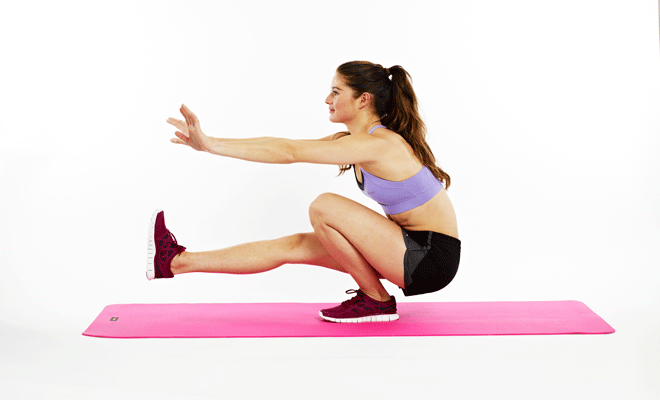The one-leg squat is an extremely versatile strength exercise.

Benefits
If you had time for only one strengthening exercise in your training programme, it would have to be the one-leg squat. That’s because the one-leg squat is the most useful, time-efficient, and versatile exercise for improving running-specific leg strength. The squat is actually a positive because it places larger-than-usual eccentric strains on the key muscle groups in the legs – the quads, hamstrings, and calves. This fortifies these muscles for the eccentric stresses associated with exercises like running, jogging or skipping, leading to less soreness and fewer injuries, as well as greater efficiency of movement during workouts and races.
Besides squatting lead to increases in functional strength. Balance is also improved because of the coordination needed between muscles in order to perform the squat.
When the foot hits the ground during exercise (like, running), a lot of energy goes into controlling impact forces, limiting the extent of ankle dorsiflexion, and regulating flexion at the knee and hip (not to mention the control of ankle pronation/supination and rotation plus similar side-to-side and rotational movements at the knee and hip). Partial squats develop the strength which enables you to control all of those movements optimally. Small wonder, then, that after a month or so, many runners feel much more efficient, fatigue-resistant, and powerful while doing their high-quality workouts.
Once great one-leg-squatting skill is attained – strength can be improved by shifting over to other exercises in which the support foot is called upon to get off the ground quickly and repeatedly. Such variants include one-leg hops on the spot and one-leg squats with lateral hops. These latter moves can be as strengthening as the plain one-leg squat, but lateral hops add strengthening in side-to-side and rotational planes of motion, and both additional exercises improve the rate of force production
Instruction for performing one-leg squat
Stand with your left foot forward and your right foot back, with your feet approximately one shin-length apart from front to back and hip-width apart from side to side. Maintain upright posture with your trunk and hold your hands at your sides;
- Place the toes of your right foot on a block or step 6-8 inches high, with most of your weight directed through the heel of your left foot;
- Bend the left leg and lower your body until there is an angle of 90 degrees between the thigh and lower leg;
- Return to the starting position;
- Complete 12 reps;
- Repeat with right foot forward and your left foot back;
- Rest for a few moments and repeat twice more.
Don’t wait until you get hurt to realize that you have a weak link, start strengthening it now. Strengthening a weak stabilizer muscle (or group) will increase your strength and allow you to target the prime movers in the compound exercises more effectively.